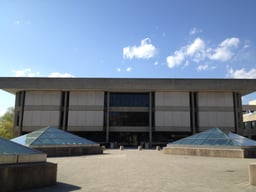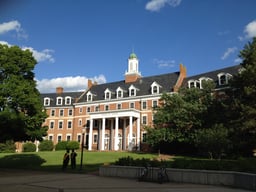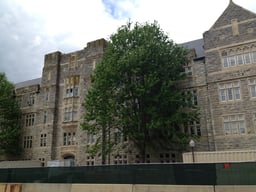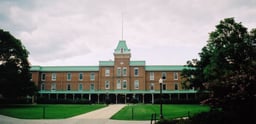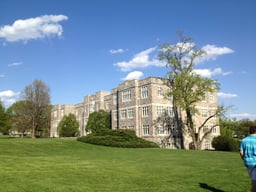Virginia Tech
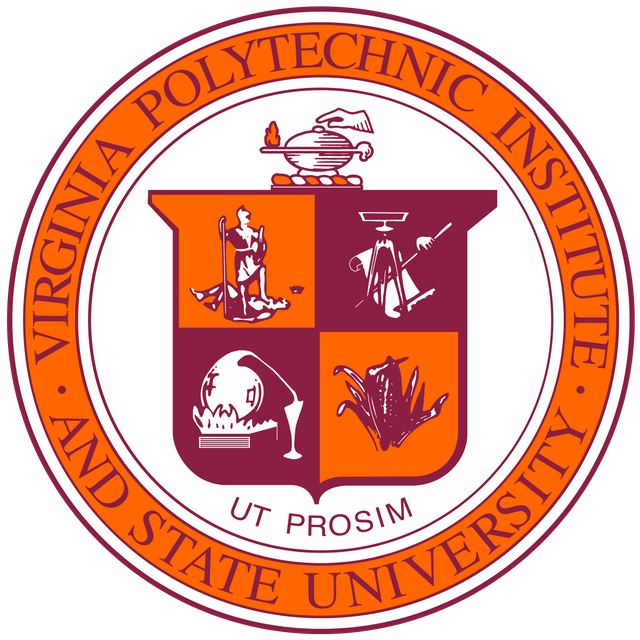
Virginia Tech

Former names | Virginia Agricultural and Mechanical College (1872–1896) Virginia Agricultural and Mechanical College and Polytechnic Institute (1896–1944) Virginia Polytechnic Institute (1944–1970) |
|---|---|
| Motto | Ut Prosim (Latin) |
Motto in English | That I May Serve |
| Type | Public Land-grant Space-grant Sea-grant Senior military college |
| Established | June 20, 1872 (1872-06-20) |
Academic affiliations |
|
| Endowment | $1.15 billion (2018)[1] |
| Budget | $1.5 billion[2] |
| President | Timothy D. Sands[3] |
| Provost | Cyril Clarke[4] |
Academic staff | 1,395[5] |
| Students | 33,403[6][7] |
| Undergraduates | 26,623[6] |
| Postgraduates | 6,780[6] |
| Location | Blacksburg ,Virginia ,United States 37°13.5′N 80°25.5′W [147] |
| Campus | College town 2,600 acres (11 km2; 4.1 sq mi) |
| Colors | Chicago Maroon and Burnt Orange[8] |
| Nickname | Hokies |
Sporting affiliations | NCAA Division I – ACC |
| Mascot | HokieBird |
| Website | www.vt.edu [148] |
| University rankings | |
| National | |
| ARWU[62] | 67–94 |
| Forbes[63] | 108 |
| Times/WSJ[64] | 106 |
| U.S. News & World Report[65] | 74 |
| Washington Monthly[66] | 42 |
| Global | |
| ARWU[67] | 201–300 |
| QS[68] | 327 |
| Times[69] | 201–250 |
| U.S. News & World Report[70] | 257 |
USNWR professional/grad rankings [71] | |
| Biological Sciences | 73 |
| Chemistry | 67 |
| Clinical Psychology | 47 |
| Computer Science | 40 |
| Earth Sciences | 28 |
| Economics | 59 |
| Education | 93 |
| English | 91 |
| Mathematics | 62 |
| Physics | 61 |
| Psychology | 81 |
| Public Affairs | 39 |
| Public Health | 89 |
| Sociology | 47 |
| Statistics | 61 |
| Veterinary Medicine | 17 |
USNWR Engineering grad rankings [71] | |
| Civil | 9 |
| Environmental/ Environmental Health | 7 |
| Industrial/Manufacturing/Systems | 4 |
USNWR global ranking [72] | |
| Agricultural Sciences | 107 |
| Biology & Biochemistry | 217 |
| Chemistry | 253 |
| Clinical Medicine | 592 |
| Computer Science | 69 |
| Engineering | 64 |
| Environment/Ecology | 163 |
| Geosciences | 178 |
| Materials Science | 221 |
| Microbiology | 158 |
| Molecular Biology & Genetics | 358 |
| Physics | 406 |
| Plant & Animal Science | 81 |
| Social Sciences & Public Health | 162 |
Virginia Polytechnic Institute and State University, commonly known as Virginia Tech and by the initials VT and VPI,[9] is a public, land-grant, research university with its main campus in Blacksburg, Virginia. It also has educational facilities in six regions statewide and a study-abroad site in Riva San Vitale, Switzerland. Through its Corps of Cadets ROTC program, Virginia Tech is also designated as one of six senior military colleges in the United States.[10]
Virginia Tech offers 280 undergraduate and graduate degree programs to some 34,400 students and manages a research portfolio of $522 million, placing it 46th among universities in the U.S. for research expenditures and the only Virginia school listed among the top 50.[11] Virginia Tech is the state's second-largest public university by enrollment.[12] The deadliest mass shooting on an American college campus occurred on campus in 2007, during which a student fatally shot 32 other students and faculty members and wounded 23 other people.
Former names | Virginia Agricultural and Mechanical College (1872–1896) Virginia Agricultural and Mechanical College and Polytechnic Institute (1896–1944) Virginia Polytechnic Institute (1944–1970) |
|---|---|
| Motto | Ut Prosim (Latin) |
Motto in English | That I May Serve |
| Type | Public Land-grant Space-grant Sea-grant Senior military college |
| Established | June 20, 1872 (1872-06-20) |
Academic affiliations |
|
| Endowment | $1.15 billion (2018)[1] |
| Budget | $1.5 billion[2] |
| President | Timothy D. Sands[3] |
| Provost | Cyril Clarke[4] |
Academic staff | 1,395[5] |
| Students | 33,403[6][7] |
| Undergraduates | 26,623[6] |
| Postgraduates | 6,780[6] |
| Location | Blacksburg ,Virginia ,United States 37°13.5′N 80°25.5′W [147] |
| Campus | College town 2,600 acres (11 km2; 4.1 sq mi) |
| Colors | Chicago Maroon and Burnt Orange[8] |
| Nickname | Hokies |
Sporting affiliations | NCAA Division I – ACC |
| Mascot | HokieBird |
| Website | www.vt.edu [148] |
| University rankings | |
| National | |
| ARWU[62] | 67–94 |
| Forbes[63] | 108 |
| Times/WSJ[64] | 106 |
| U.S. News & World Report[65] | 74 |
| Washington Monthly[66] | 42 |
| Global | |
| ARWU[67] | 201–300 |
| QS[68] | 327 |
| Times[69] | 201–250 |
| U.S. News & World Report[70] | 257 |
USNWR professional/grad rankings [71] | |
| Biological Sciences | 73 |
| Chemistry | 67 |
| Clinical Psychology | 47 |
| Computer Science | 40 |
| Earth Sciences | 28 |
| Economics | 59 |
| Education | 93 |
| English | 91 |
| Mathematics | 62 |
| Physics | 61 |
| Psychology | 81 |
| Public Affairs | 39 |
| Public Health | 89 |
| Sociology | 47 |
| Statistics | 61 |
| Veterinary Medicine | 17 |
USNWR Engineering grad rankings [71] | |
| Civil | 9 |
| Environmental/ Environmental Health | 7 |
| Industrial/Manufacturing/Systems | 4 |
USNWR global ranking [72] | |
| Agricultural Sciences | 107 |
| Biology & Biochemistry | 217 |
| Chemistry | 253 |
| Clinical Medicine | 592 |
| Computer Science | 69 |
| Engineering | 64 |
| Environment/Ecology | 163 |
| Geosciences | 178 |
| Materials Science | 221 |
| Microbiology | 158 |
| Molecular Biology & Genetics | 358 |
| Physics | 406 |
| Plant & Animal Science | 81 |
| Social Sciences & Public Health | 162 |
History
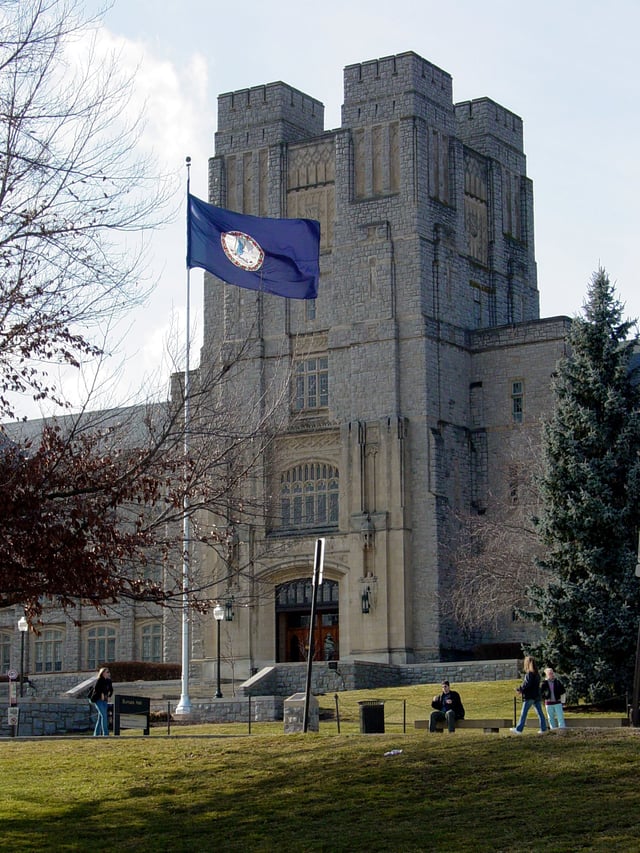
Virginia Tech's Burruss Hall
In 1872, with federal funds provided by the Morrill Act of 1862, the Virginia General Assembly purchased the facilities of Preston and Olin Institute, a small Methodist school for boys in Southwest Virginia's rural Montgomery County. That same year, 250 acres (100 ha) of the adjoining Solitude Farm including the house and several farm buildings on the estate were acquired for $21,250[13][14] The commonwealth incorporated a new institution on the site, a state-supported land-grant military institute named Virginia Agricultural and Mechanical College.[15]
Virginia Tech's first student, Addison "Add" Caldwell registered on October 1, 1872, after hiking over 25 miles from his home in Craig County, Virginia. A statue, located in the Upper Quad of campus commemorates Add's journey to enroll.[16] First-year cadets and their training cadre re-enact Addison Caldwell's journey every year in the Caldwell March. They complete the first half of the 26-mile march in the fall and the second half in the spring.[17]
The first five presidents of Virginia Agricultural and Mechanical College served in the Confederate States Army or the Confederate government during the Civil War as did many of its early professors including the first Commandant, James H. Lane, a VMI graduate and former Confederate General who taught civil engineering and commerce at the college and is the namesake of Lane Hall, one of the oldest buildings on campus, built in 1888.[18] Its third president, Thomas Nelson Conrad, was a notorious Confederate spy who ran a covert intelligence gathering operation from a home in the heart of Washington, D.C. His wartime exploits included among other things, hatching a plot to assassinate the Commanding General of the United States Army, Winfield Scott, that was vetoed by the Confederate government who feared that the elderly, infirm, and obese Scott would be replaced by someone more fit for command; sneaking into the War Office during lunch hour to lift copies of documents describing General McClellan's battle plans for the Peninsula Campaign, a large-scale offensive by the Union Army to capture the Confederate capitol at Richmond from the desk of a friend who was a double agent; conspiring to kidnap U.S. President Abraham Lincoln from the White House; and jumping from a speeding train to escape after being captured by Union forces.[19] Its sixth president and the namesake of Barringer Hall, Paul Brandon Barringer, was the son of Confederate General Rufus Barringer and a nephew of Confederate Generals Stonewall Jackson and Daniel Harvey Hill.
In a nod to this southern heritage the Confederate Battle Flag was traditionally waved by cheerleaders at Virginia Tech football games and the Highty-Tighties played Dixie as a fight song when the Hokies scored a touchdown. A large Confederate flag also hung inside Cassell Colosseum where Virginia Tech basketball games are played.[20] Since 1963, "Skipper", a replica of a Civil War cannon has been fired at football games by members of the Corps of Cadets when the team scores.[21] The Confederate Flag was also prominently featured on all Virginia Tech class rings.[22] The display of the Confederate flag at athletic events ended in the late 1960s after Marguerite Harper, a black woman attending Virginia Tech on a Rockefeller Scholarship for culturally disadvantaged students, was elected to the student senate during her sophomore year and made a successful resolution to end the practice. Following the resolution there was a large demonstration in opposition to the removal of the Confederate flag. The campus was covered in Confederate flags and Dixie was blasting from dormitory windows. Harper and her white roommate received hate mail and threatening phone calls but the resolution stood and the display of the rebel flag ended in 1969.[23] The Confederate flag on Virginia Tech class rings became optional in 1972 and could be left off of the ring at the student's request.[24] The Confederate flag has since been removed from class ring designs entirely.
College reorganizations
Under the 1891–1907 presidency of John McLaren McBryde, the school organized its academic programs into a traditional four-year college and a graduate department was founded. The evolution of the school's programs led to a name change in 1896 to Virginia Agricultural and Mechanical College and Polytechnic Institute. The "Agricultural and Mechanical College" portion of the name was popularly omitted almost immediately; in 1944, the name was officially changed to Virginia Polytechnic Institute (VPI).[25]
In 1923, VPI changed a policy of compulsory participation in the Corps of Cadets from four years to two years. In 1931, VPI began teaching classes at the Norfolk Division of the College of William and Mary (now Old Dominion University).[26] This program eventually developed into a two-year engineering program that allowed students to transfer to VPI for their final two years of degree work.
In 1943, VPI merged with Radford State Teachers College, in nearby Radford which became VPI's women's division; the merger was dissolved in 1964. Today, Radford University is a co-educational research university and enrolls nearly 10,000 students and offers more than 150 undergraduate and graduate programs.[27]
Post-World War II
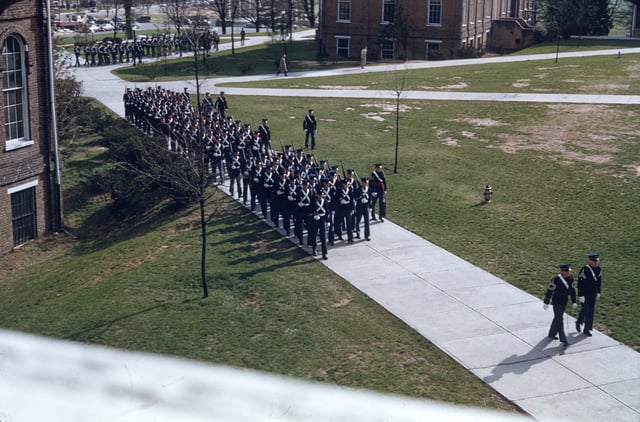
Corps of Cadets on campus ca 1952
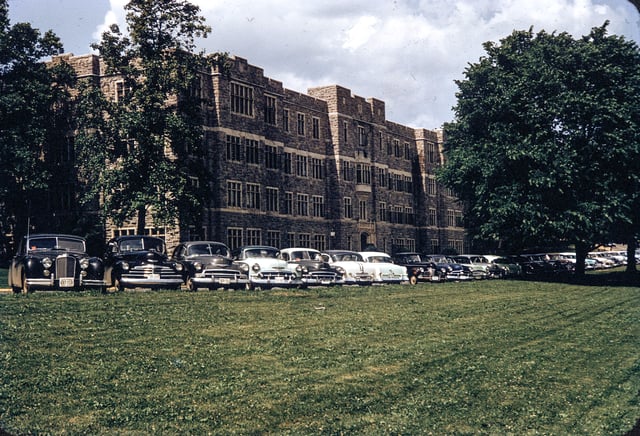
Chevrolet Deluxe cars parked in front of Patton Hall, ca 1952
In 1953 under the leadership of President Walter Stephenson Newman, VPI became the first historically white, four-year public institution among the 11 states in the former Confederacy to admit a black undergraduate. Three more black students were admitted in 1954. At the time Virginia still enforced Jim Crow laws and largely practiced racial segregation in public and private education, churches, neighborhoods, restaurants, and movie theaters and these first black students at VPI were not allowed to live in residence halls or eat in the dining halls on campus. Instead, they boarded with African American families in Blacksburg. In 1958 Charlie L. Yates made history as the first African American to graduate from VPI. Yates earned a bachelor's degree in mechanical engineering, with honors, and was hailed as the first African American "to be graduated from any major Southern engineering institute," according to news reports at the time.[28]
VPI President T. Marshall Hahn, whose tenure ran from 1962 to 1974,[29] was responsible for many of the programs and policies that transformed VPI from a small, historically white, predominately male, military institute with a primary focus on undergraduate teaching into a major co-educational research university. The student body that had been approximately 5,682 in 1962 increased by roughly 1,000 students each year, new dormitories and academic buildings were constructed, faculty members were added – in 1966, for instance, more than 100 new professors joined the faculty – and research budgets were increased.[29] During Hahn's tenure, not only did the university graduate its first Rhodes Scholar, W.W. Lewis, Class of 1963,[30] the requirement for male students to participate in the Corps of Cadets for two years was dropped in 1964. Beginning in the fall 1973, women could participate in the Corps, making Virginia Tech among the nation's first senior military colleges to integrate women.[31]
In 1970, the state legislature allowed VPI university status and gave it the present legal name, Virginia Polytechnic Institute and State University. In the early 1990s, university administration authorized the official use of "Virginia Tech" as equivalent to the full legal name; it has been used as the first-reference name for the school's athletic teams since the 1970s. However, diplomas and transcripts still spell out the formal name. Similarly, the abbreviation "VT" is far more common today than either VPI or VPI&SU.
Vietnam War era
During the Vietnam War students on college campuses across the nation protested the draft and U.S. involvement in the conflict. Despite its long history as a military school, Virginia Tech was no exception. Most protests at Virginia Tech were small sit-ins and teach-ins, but In mid-April 1970 a group of anti-war protesters including students and faculty members disrupted a Corps of Cadets drill on campus. The Virginia Tech administration under Dr. Hahn took swift action. The students involved were suspended and the faculty members involved were fired from the university and the administration went to court and obtained an injunction to prevent them from repeating the act. This succeeded in calming tensions on campus, but only for a few weeks.[32]
Tensions on campus reached the boiling point several days following the Kent State Shootings when on May 12, 1970 a large mob including students and a number of non-student anti-war protesters enraged by the Kent State incident and angered by the administration's disciplinary actions in response to a number of recent infractions by protesters including; vandalism of university property, a series of potentially dangerous fires set on campus, breaking and entering into a university building, and a sit-in in Cowgill Hill, seized Williams Hall and barricaded themselves inside.[33] The administration responded quickly calling in law enforcement and early the following morning Virginia State Troopers forced their way into Williams Hall and began rounding up the protesters. Once inside the building the police discovered bomb making materials and determined that the students had apparently intended to build a firebomb. The first few protesters were dragged out of the building; the rest left peacefully and were arrested and taken to the Montgomery County jail. The students involved in the seizure, were suspended from Virginia Tech and given twenty-four hours to remove their belongings from campus after being released from jail.
Several more anti-war protests occurred at Virginia Tech during the early 1970s but none turned violent.[32]
Twenty-first century
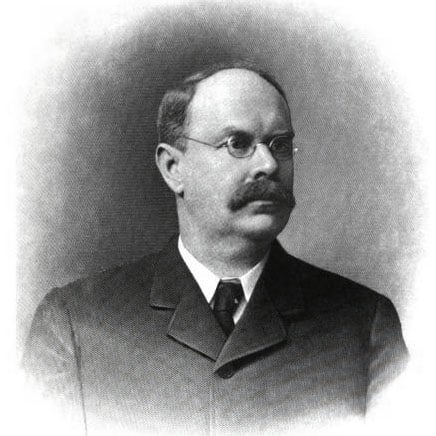
VT's 6th president, Dr. Paul Barringer
The early decades of this century have seen expansion across the university's institutions in both physical and population sizes. In 2001 Virginia Tech acquired the 326 acre Heth Farm adjacent to the Virginia Tech campus.[34] The Virginia Tech Carilion School of Medicine and Research Institute was created with a strategic partnership with the Carilion Clinic and the Governor of Virginia. These years also brought about the rapid development of the university's professional schools of graduate education, and business programs. Virginia Tech brought in over a half-billion in research expenditures in 2014.[35]
Following Amazon's unveiling of their second headquarters in Crystal City, VA, Virginia Tech announced plans to build a $1 billion graduate research center adjacent to Amazon's facility. The Virginia Tech Innovation Campus will be housed at a 1 million-square-foot campus in Alexandria. It is expected to educate hundreds of graduate students. The Virginia Tech Innovation Campus will be focused on computer science and software engineering, with specializations in areas including artificial intelligence, cyber-security and data analytics.[36]
Due to rapid growth of incoming freshmen classes, the university announced in 2019 that it plans to offer 1,559 incoming, in-state freshmen financial incentives to skip the 2019–20 school year in Blacksburg.[37] Expecting a larger-than-planned class size, the university allegedly budgeted $3.3 million for the endeavor.
2007 shooting
On April 16, 2007, Virginia Tech student Seung-Hui Cho fatally shot 32 faculty members and students and wounded 17 others in two locations on campus before killing himself as police breached the doors of Norris Hall which Cho had chained closed before starting his killing spree. The massacre is the deadliest mass shooting on a college campus, surpassing Charles Whitman's rampage at the University of Texas in 1966. Although it was at the time the deadliest mass shooting committed by a lone gunman in U.S. history, it has since been surpassed by two shootings at an Orlando nightclub and an outdoor music festival in Las Vegas.[38][39][40] It is the second deadliest school massacre in U.S. history surpassed only by the Bath School bombing in 1927 that killed 44.[41]
The Virginia Tech massacre led to an intense nationwide debate over gun rights, gun safety and efficacy of gun free zones. The mass shooting prompted many states to introduce legislation to prohibit public colleges and universities from banning concealed weapons on campus for permit holders. In 2013, at least nineteen states introduced legislation to allow concealed carry on campus in some form and in the 2014 legislative session, at least fourteen states introduced similar legislation. Tennessee passed a bill in 2016, permitting faculty members to carry handguns on campus after notifying local law enforcement. In 2015, Texas became the eighth state to allow concealed weapons on college campuses. In December 2016, Governor John Kasich signed a bill into law which lifted Ohio's statewide ban on firearms on college campuses leaving the decision to individual institutions.[42] In 2017 Georgia became the tenth state to prohibit colleges and universities from banning concealed weapons on campus.[43] Although Virginia law allows individual institutions to make the decision regarding whether to allow concealed weapons on campus, Virginia Tech continues to ban concealed carry permit holders from carrying guns on campus.[44]
2009 beheading
On January 21, 2009 Virginia Tech graduate student Xin Yang was beheaded by fellow graduate student Haiyang Zhu in the Au Bon Pain cafe in the university's Graduate Life Center on campus. Zhu, 25 was pursuing a doctorate in agricultural and applied economics. Yang, 22, had just arrived at the university two weeks earlier to study for a master's degree in accounting. She had listed Zhu as her emergency contact on school records. The extent of their relationship is not clear, but both were international students from China. Witnesses told police that Zhu and Yang were drinking coffee together and had not been arguing before the attack. By the time police arrived at the scene less than a minute after receiving two 911 calls, Zhu had decapitated Yang and was holding her severed head in his hand.[45] The brutal murder stunned a campus that still had vivid memories of the mass shooting in April 2007, when Cho killed 32 people before taking his own life.[45] Haiyang, a native of Ningbo pleaded guilty to first-degree murder in connection with the death of Xin Yang, of Bejing in December 2009. In April 2010 Zhu was sentenced to life in prison without parole.[46]
2011 shooting
In 2011, another shooting occurred on campus which resulted in two deaths. The gunman who was a part-time student at nearby Radford University shot and killed Virginia Tech Police Officer Deriek Crouse and then committed suicide. The officer was killed after pulling a driver over in a traffic stop. The gunman who a day earlier had stolen a Mercedes SUV at gunpoint, but was not involved in the traffic stop, walked into the parking lot and ambushed the officer.[47] The shooting took place on the same day Virginia Tech officials were in Washington D.C., fighting a government fine over their alleged mishandling of the 2007 massacre where 33 people were killed.[48][49][50]
List of presidents
| Charles Landon Carter Minor | 1872–1879 |
|---|---|
| Charles Robert Scott Ship | 1880 |
| John Lee Buchanan | 1880–1881 |
| Thomas Nelson Conrad | 1882–1886 |
| Lunsford Lindsay Lomax | 1886–1891 |
| John McLaren McBryde | 1891–1907 |
| Paul Brandon Barringer | 1907–1913 |
| Joseph Dupuy Eggleston | 1913–1919 |
| Julian Ashby Burruss | 1919–1945 |
| John Redd Hutcheson | 1945–1947 |
| Walter Stephenson Newman | 1947–1962 |
| Thomas Marshall Hahn, Jr. | 1962–1974 |
| William Edward Lavery | 1975–1987 |
| James Douglas McComas | 1988–1994 |
| Paul Ernest Torgersen | 1993–2000 |
| Charles William Steger | 2000–2014 |
| Timothy David Sands[3] | 2014–present |
Official names
| Virginia Agricultural and Mechanical College | 1872–1896 |
|---|---|
| Virginia Agricultural and Mechanical College and Polytechnic Institute | 1896–1944 |
| Virginia Polytechnic Institute | 1944–1970 |
| Virginia Polytechnic Institute and State University | 1970–present |
Academics
Virginia Tech offers 116 bachelor's degree programs through its seven undergraduate academic colleges, 160 master's and doctoral degree programs through the Graduate School, and a professional degree from the Virginia–Maryland College of Veterinary Medicine. In addition, the Virginia Tech Carilion School of Medicine and Research Institute, is a public/private partnership jointly managed by Virginia Tech and the Carilion Clinic – formerly named Carilion Health System which was founded on January 3, 2007.[52]
These colleges/schools include:
| Enrollment | Undergrads | Grad/Professional | Total |
| Agriculture & Life Sciences | 2,729 | 425 | 3,154 |
| Architecture & Urban Studies | 1,814 | 319 | 2,133 |
| Business | 4,402 | 164 | 4,566 |
| Engineering | 8,054 | 2,023 | 10,077 |
| Liberal Arts & Human Sciences | 3,714 | 627 | 4,341 |
| Natural Resources & Environment | 931 | 163 | 1,094 |
| Science | 4,300 | 595 | 4,895 |
| Veterinary Medicine | 0 | 619 | 619 |
| Intercollege | 1,196 | 229 | 1,425 |
| GRAND TOTAL[6] | 27,140 | 5,164 | 32,304 |
| College/School founding[53] | |||
|---|---|---|---|
| College/School | Year founded | ||
| Graduate School | 1891 | ||
| College of Engineering | 1903 | ||
| College of Agriculture and Life Sciences | 1903 | ||
| College of Architecture and Urban Studies | 1964 | ||
| College of Liberal Arts and Human Sciences | 1964 (split from College of Arts and Sciences in 2003) | ||
| College of Science | 1964 (split from College of Arts and Sciences in 2003) | ||
| Pamplin College of Business | 1965 | ||
| College of Veterinary Medicine | 1978 | ||
| College of Natural Resources and Environment | 1992 | ||
| Carilion School of Medicine and Research Institute | 2007 | ||
Admissions
| Number of freshman applicants | 32,103 |
|---|---|
| Participated in Early Decision Plan | 18% |
| Average GPA of admitted students | 4.15 |
| Average SAT scores of admitted students | 1310 |
| Middle 50% ACT scores of admitted students | 24 to 28[55] |
Virginia Tech received a record number of nearly 22,500 applications for the fall 2015 freshman class, an increase of 7.6% from the previous year's 20,897 applications. The typical student offered admission had a high-school grade point average of 4.00, with the middle 50 percent ranging from 3.84 and 4.27. The average cumulative SAT score was 1250 (out of 1600), with a middle range ranging from 1160 to 1340. Of the 5,518 students who accepted the offers of admission, 18 percent accepted under the Early Decision Plan.[56] The Office of Undergraduate Admissions is located within the Visitor and Undergraduate Admissions Center.[57]
Virginia Tech offers an undergraduate program known as University Honors, which provides accepted honors students 11 different ways to earn Honors credits towards one of the five Honors degree options. Once admitted, Honors students are required to maintain a 3.5 GPA in order to remain in the program. Roughly one-fourth of the approximately 1,600 University Honors students live in one of the two University Honors residential halls, the Honors Residential College located in East Ambler-Johnston and the Hillcrest Honors Community.[58]
For the 2013–14 academic year, the Graduate School at Virginia Tech enrolled 6,723 graduate students (4,465 full-time; 2,258 part-time) in its masters and doctoral programs.[59]
The Pamplin College of Business, received 381 applications for its incoming Evening MBA program, and offered admission to 142. The class's average GMAT was 610, and mean undergraduate GPA was 3.4.[60]
The Virginia Tech Carilion School of Medicine in Roanoke, Va., received 4,403 applications for its eighth incoming class, the class of 2021, and offered admission to 42. The class's MCAT scores range was 503–520 (median 512, mean 512), and mean undergraduate GPA was 3.57.[61]
Rankings
In U.S. News & World Report's list of "2020 Best Colleges", Virginia Tech ranked tied for 74th overall and tied at 42nd for "Most Innovative" among national universities, and 30th among public ones.[73]
The College of Engineering undergraduate program is ranked 13th in the nation among all accredited engineering schools that offer doctorates, and sixth among engineering schools at U.S. public universities, tying with Texas A&M University. Several Virginia Tech undergraduate engineering specialties ranked among the top 20 of their respective peer programs: aerospace and ocean engineering, 14th; civil engineering, 9th; electrical and computer engineering, 15th; engineering science and mechanics, eighth; environmental engineering, 9th; industrial and systems engineering, eighth; mechanical engineering, 14th; biological systems engineering, 11th; and chemical engineering, 19th.[74]
In 2019, Niche ranked Virginia Tech's Food/Nutrition at 2nd in the country (only beaten by Cornell) and 9th in Agricultural Sciences.
The Pamplin College of Business undergraduate program was ranked 39th (2014) among the nation's undergraduate business programs and 23rd among public institutions. Pamplin's overall ranking places it in the top 10 percent of the approximately 445 U.S. undergraduate programs accredited by the Association to Advance Collegiate Schools of Business International.[75] Pamplin's Evening MBA program was ranked 16th overall by U.S. News & World Report's 2014 Best Graduate Business School Ranking.[76] The Master of Information Technology program, jointly sponsored by the Pamplin College of Business and the College of Engineering, is ranked No. 2 in U.S. News & World Report's Best Online Graduate Computer Information Technology Programs.[77] This interdisciplinary program is offered entirely online.[77]
Programs in the College of Architecture and Urban Studies (CAUS), including architecture + design, landscape architecture, urban planning, and public administration, are consistently ranked among the very best in the country. In its 2016 "America's Best Architecture & Design Schools" report, DesignIntelligence (the only national college ranking survey focused exclusively on design) ranked the undergraduate architecture program 3rd nationally among both public and private universities. The graduate architecture program ranked 9th in the nation.[78] For 2013, DesignIntelligence ranked the university's undergraduate and graduate landscape architecture programs No. 2 in the nation. In addition, DesignIntelligence ranked the university's undergraduate interior design program 6th and undergraduate industrial design program 3rd.[79] The Planetizen 2012 Guide to Graduate Urban Planning Programs ranks Virginia Tech's MURP program as 19th. It is the best ranked program in the Commonwealth of Virginia and the Appalachian region. This latest edition features new listings of the top master's degree programs in urban planning, as well as updated profiles for 100 planning programs in the U.S. and Canada. Virginia Tech's MURP program performed well overall and was also rated among the best programs in Technology, Land Use Planning, Environmental Planning, and Growth Management.[80]
Programs in the College of Natural Resources and Environment consistently rank among the top of their type in the nation. The college's wildlife program is ranked first by its peers, and the fisheries program is ranked second. In a recently published study of the research impact of North American forestry programs, the Journal of Forestry ranked Virginia Tech's programs second on the perceptions-based composite score and third on the citations- and publications-based index. The wood science and forest products program is listed as an accredited program by the Society of Wood Science and Technology or SWST,[81] and is recognized as one of the top programs in its category in North America. Virginia Tech is classified as "R1" (research university with highest research activity) under the Carnegie Classification of Institutions of Higher Education.
Student affairs rankings
Virginia Tech received the following rankings by The Princeton Review in its 2017 Best 380 Colleges Rankings:[85]
| Category | Rankings |
|---|---|
| Happiest Students | 7th overall |
| Best Campus Food | 4th overall |
| Best Quality of Life | 1st overall |
| Their Students Love These Colleges | 1st overall |
| Town-Gown Relations are Great | 7th overall |
| Best Alumni Network | 10th overall |
| Lots of Race/Class Interaction | 7th overall |
| Colleges That Pay You Back without Aid | 18th overall |
Research
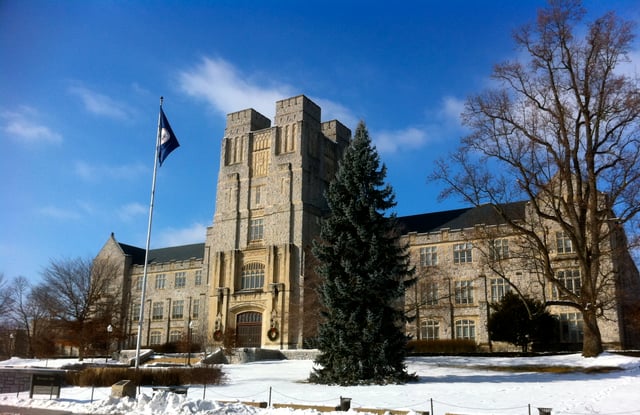
Burruss Hall houses the Office of the Vice President for Research and Innovation.
Virginia Tech's research and development expenditures (R&D) were $522 million in fiscal year 2017, which ranked 46th among education institutions in the nation according to the National Science Foundation.[11] As a result, Virginia Tech marked its 15th consecutive year of research growth, with the university's research portfolio more than doubling from $192.7 million in fiscal year 2000. The only Virginia institution in the top 50 of the NSF's rankings for research expenditures, Virginia Tech is No. 23 among public universities. The university's research expenditures rank it in the top 5 percent of more than 900 research universities and colleges. Each year, the university receives thousands of awards to conduct research from an ever-expanding base of sponsors. Researchers pursue new discoveries in agriculture, biotechnology, information and communication technology, human health, transportation, energy management (including leadership in fuel-cell technology and power electronics), security, sustainability, and a wide range of other engineering, scientific, social science, and creative fields. This research led to 36 patents and 17 license and option agreements in fiscal year 2013.[86] []
| 2009 | $399 million |
|---|---|
| 2011 | $450 million |
| 2013 | $496 million |
| 2015 | $504 million |
| 2017 | $522 million |
Research institutes

The Biocomplexity Institute of Virginia Tech has facilities in Blacksburg and in the National Capital Region.
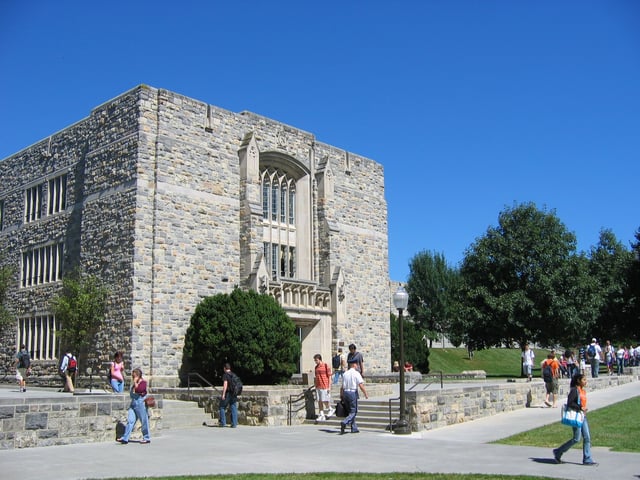
Norris Hall houses the Center for Peace Studies and Violence Prevention and some offices for the Department of Engineering Science and Mechanics.
Fralin Life Science Institute
Institute for Creativity, Arts and Technology (ICAT)
Institute for Critical Technology and Applied Science (ICTAS)
Institute for Society, Culture, and Environment (ISCE)
Biocomplexity Institute of Virginia Tech (disbanded and absorbed into Fralin Life Science Institute)[87]
Fralin Biomedical Research Institute at VTC
Virginia Tech Transportation Institute (VTTI)
Hume Center for National Security and Technology
Fralin Life Science Institute
The Fralin Life Science Institute is an expansion of the Fralin Biotechnology Center, which was established in 1991.[88] Research at the institute is focused on the areas of vector-borne disease; infectious disease and microbial sciences; plant sciences; obesity; cancer biology; and ecology and organismal biology.[89]
Biocomplexity Institute of Virginia Tech
The Biocomplexity Institute of Virginia Tech, formerly known as the Virginia Bioinformatics Institute, is a bioinformatics, computational biology, and systems biology research facility that opened in 2000 on Virginia Tech's main campus in Blacksburg, Virginia. The institute houses more than 200 employees and multiple supercomputing clusters, and has more than $109 million in active research awards.
Virginia Tech Transportation Institute (VTTI)
The Virginia Tech Transportation Institute (VTTI) was founded as the Center for Transportation Research in 1988, and employs more than 350 personnel. VTTI has more than $125 million in active research awards, and has a mission to save lives, save time, save money, and protect the environment. It is the second largest university-level transportation institute in the United States, and the largest group of driving safety researchers in the world. Facilities include the 2.2-mile (3.5 km), two-lane, fully instrumented Virginia Smart Road; connected-vehicle test beds in Southwest and Northern Virginia; more than 83,000 square feet of office and laboratory space; the VTTI/Center for Injury Biomechanics Crash Sled Lab; and the National Tire Research Center in Southern Virginia.[90] These laboratories include an asphalt lab, fully equipped garages, instrumentation bays, and a machine shop for working on VTTI's vehicle fleet.[91]
VTTI conducts applied research to address transportation challenges from various perspectives: vehicle, driver, infrastructure, materials, and environment.[35] Most notable among VTTI endeavors are its naturalistic driving studies. These studies particularly utilize VTTI's data acquisition systems, which gather continuous video and driving performance data in real-world driving conditions. These systems have been installed in nearly 4,000 passenger vehicles, commercial trucks and motor coaches, and motorcycles.[94]
Institute for Critical Technology and Applied Science (ICTAS)
Since 2005, the Institute for Critical Technology and Applied Science (ICTAS) has made efforts to build capacity at the intersection of engineering, science, biology, and the humanities. Thrust areas include nuclear engineering, nanoscale science and engineering, nano-bio interface, sustainable energy, safe and sustainable water, national security, cognition and communication systems, renewable materials, and emerging technologies. The first director was Roop L. Mahajan (2005-2016) and the current director is Dr. Stefan Duma (2016–present).[35]
Institute for Society, Culture, and Environment (ISCE)
The Institute for Society, Culture, and Environment (ISCE) was created in 2007 to support interdisciplinary research and scholarship.[97]
Fralin Biomedical Research Institute at VTC
The Fralin Biomedical Research Institute at VTC is in Roanoke, Virginia and is an integral component of the new medical research and education initiative embodied by the Virginia Tech Carilion School of Medicine and Fralin Biomedical Research Institute.[97]
Virginia Tech Research Center – Arlington (VTRC-A)
The Virginia Tech Research Center – Arlington (VTRC-A) opened at 900 N. Glebe Road in June 2011. The building is located in the Ballston area of Arlington.[98]
A number of established Virginia Tech research centers and institutes are located in this facility[99]
Other areas of research
Other research conducted throughout the university's colleges and interdisciplinary groups includes high-performance computing; advanced materials; wireless telecommunication; housing; human and animal health; cognition, development, and behavior; the environment; and energy, including power electronics, biofuels, fuel cells, and solar-powered building structures.[100]
The School of Biomedical Engineering & Sciences partners with the College of Engineering, Wake Forest University School of Medicine, and the College of Veterinary Medicine. Virginia Tech's research includes biomechanics, cellular transport, computational modeling, biomaterials, bioheat and mass transfer, biofluid mechanics, instrumentation, ergonomics, and tissue engineering.
Virginia Tech Intellectual Properties Inc. (VTIP) was established in 1985 as a nonprofit corporation to support the mission of the university by protecting and licensing intellectual properties that result from research performed by Virginia Tech faculty, staff members, and students. During fiscal year 2012, 17 U.S. patents and six foreign patents were issued to VTIP, and 32 license and option agreements were signed. In addition, VTIP reported $2,269,991 in license revenue.[101]
The Virginia Tech Applied Research Corporation (VT-ARC), is a private nonprofit corporation affiliated with Virginia Tech that was established in fall 2010. With offices in Northern Virginia and Blacksburg, VT-ARC fosters applied research and development, and management of large contract research projects. VT-ARC applies the university's scholarly research achievements, expertise, and collaborations across multiple disciplines to solve complex national challenges in intelligence, cyber security and information technology, national security, energy, and health care.[90]
The Virginia Cooperative Extension programs are delivered through a network of faculty, 107 county and city offices, 11 agricultural research and Extension centers, and six 4-H educational centers. The system incorporates the expertise of faculty at the College of Agriculture and Life Sciences and through research and Extension efforts, the college helped elevate the state's agricultural exports to record numbers. In 2013, exports in the Commonwealth of Virginia reached $2.85 billion.[90]
The Virginia Tech Corporate Research Center (VTCRC) is home to over 170 research, technology and support companies. The 230-acre (93 ha) park is located in a mountain setting, with easy access to the metropolitan areas of northern Virginia and the nation's capital. An expansion on the northwest side of the park provides enough land to construct 15 buildings in addition to the 33 single- and multi-tenant buildings currently on-site. The VTCRC employs over 2,900 employees.[102]
The Virginia Tech Institute for Policy and Governance is a nonprofit and public sector research and outreach institute for the university.
The Center for Modeling Immunity to Enteric Pathogens is a National Institute of Allergy and Infectious Diseases (NIAID)-funded program to model immune responses to gut pathogens.
The Virginia Tech Metropolitan Institute (The CMI) conducts elemental and applied research on the dynamics of metropolitan complexities, such as demographics, environment, technology, design, transportation, and governance. MI is housed within the College of Architecture and Urban Studies (CAUS) and partners closely with the faculty of the School of Public and International Affairs (SPIA) while also reaching beyond the boundaries of department, college, or university, to bring together the richest collaboration of thinkers to each research question.[103]
The Virginia Tech Language and Culture Institute (LCI) provides language-related programs and services for academic and professional development. The institute was started in the 1960s, when members of the Blacksburg chapter of the American Association of University Women decided to volunteer their time teaching English. The women held free classes in church basements or their own homes to help the spouses of international students and faculty members learn English. In 2014 LCI opened a new state-of-the-art learning center in Fairfax, Virginia that provides language-related programs and services for academic and professional development both on the main campus in Blacksburg and within the National Capital Region.[104]
Campus
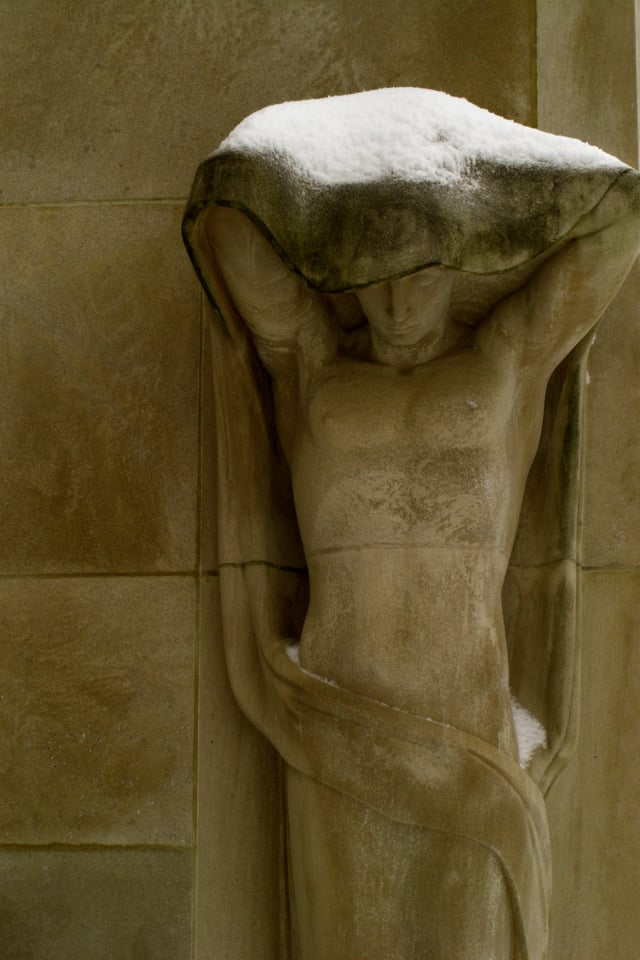
One of the War Memorial Chapel pylons, "Sacrifice", on a snowy day
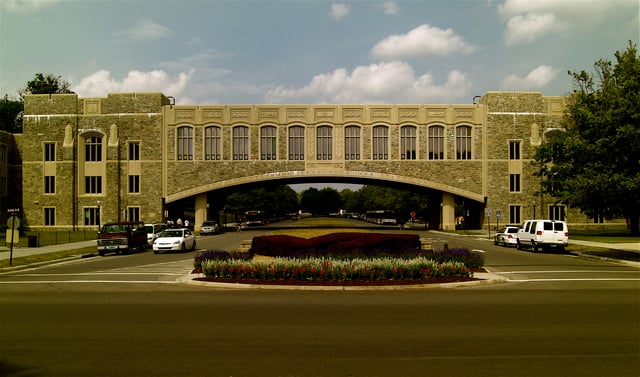
Torgersen Hall bridge over Alumni Mall is an example of architecture using Hokie Stone.
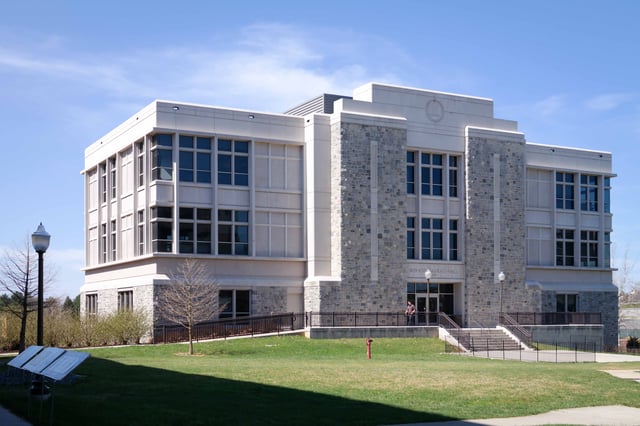
Bishop-Favrao Hall
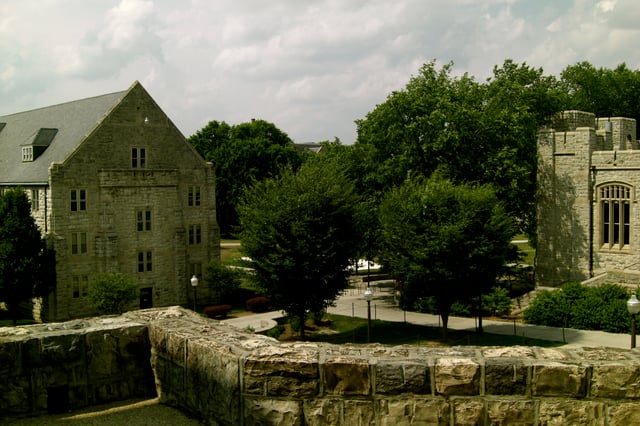
Eggleston and Owens Halls

Panoramic view of Virginia Tech's Drillfield
The Virginia Tech campus is located in Blacksburg, Virginia. The central campus is roughly bordered by Prices Fork Road to the northwest, Plantation Drive to the west, Main Street to the east, and US 460 Bypass to the south, though it has several thousand acres beyond the central campus.
In the center of the Blacksburg campus lies the Drillfield, a large oval field running northeast to southwest, encircled by a one-way street that is known as Drillfield Drive. The Drillfield's name, coined in 1926 after the completion of Virginia Tech's first real stadium, stems from its use by the Virginia Tech Corps of Cadets to conduct military drills. A waterway, Stroubles Creek, runs beneath the Drillfield on the south side. A three-sided conduit for the creek that retains the natural bed of the creek was installed in 1934, and, in 1971, the first two asphalt walks were added. The urban legend that the Drillfield is sinking at the rate of an inch per year, however, has no basis in fact.[105][106] In the summer of 2014, three dirt paths were paved as part of the university's master plan to improve the landscaping and pathways, add seating areas, and enhance path entrances around the Drillfield.[107]
On the northwestern side of the Drillfield stands the majority of the university's academic and administrative buildings, including Burruss and McBryde halls. On the southeastern side of the Drillfield stands the majority of the residential buildings, including students' residence halls, dining halls, and War Memorial Gym. Newman Library is located on the eastern side of campus and connects to Torgersen Bridge, which spans the main road into campus, Alumni Mall. North of the Drillfield and northwest of Alumni Mall lies the Upper Quad, known to many students as military campus. The Upper Quad is home to the Corps of Cadets' barracks.
On the main campus in Blacksburg, the majority of the buildings incorporate Hokie Stone as a building material. In the 1990s, a Virginia Tech Board of Visitors committee expressed an intent that henceforth Hokie Stone should be used in all buildings constructed on the central campus. In 2010, the board of visitors passed a resolution making that sentiment official university policy.[108]
Hokie Stone is generally gray, shaded by hues of brown and pink. The limestone is mined from various quarries in Southwest Virginia, Tennessee, and Alabama – one of which has been operated by the university since the 1950s. However, while it is true that the majority of buildings on campus incorporate Hokie Stone into their design, there are a few notable exceptions. For example, all buildings on the Upper Quad, including Lane Hall, are constructed of red brick. Also, a number of academic buildings were not constructed using Hokie Stone, as they were built before the institution of the rule mandating its use in all new university buildings.
Extended campuses
The university has established five branch campuses:[109]
Northern Virginia Center (National Capital Region)
Virginia Tech's presence in the Washington Metropolitan Area links regional graduate education and outreach programs that are consistent with the university's strategic research areas of excellence: energy materials and environment, social and individual transformation, health, food, and nutrition, and innovative technologies and complex systems.[115]
Supporting the university's missions is the Virginia Tech National Capital Region. The university has established collaborations and partnerships with local and federal agencies, nonprofit research organizations, businesses, and other institutions of higher education. Current locations include Alexandria, Arlington, Fairfax, Falls Church, Leesburg, Manassas, and Middleburg.
Biomedical Technology Development and Management is an executive program in the National Capital Region. The Master of Science in Biomedical Technology Development and Management (BTDM) is a graduate level degree created by Virginia Tech in response to future directions in medical product discovery and development and the emerging needs of industry and regulatory agencies. Curriculum for the degree program integrates science with technology, management, ethics, and public policy, and draws on the strengths of Virginia Tech in science, industrial and systems engineering, business and management, and medical research programs.[116]
International campuses
Caribbean Center for Education and Research (CCER)
Located on the eastern tip of the Dominican Republic, the Caribbean Center for Education and Research (CCER) in Punta Cana provides a base for Virginia Tech faculty to conduct research as well as instruct students on biodiversity, environmental and social sustainability, global issues in natural resources, and hotel and tourism management. The center is the product of a partnership between Virginia Tech and the PUNTACANA Ecological Foundation (PCEF) and the PUNTACANA Resort and Club. PCEF maintains a 2,000-acre (810 ha) natural forest reserve, 14 kilometres (8.7 mi) of protected coral reef, freshwater lagoons and coastal mangroves.[119]
Center for European Studies and Architecture (CESA)
Renamed the Steger Center for International Scholarship in 2014,[120] the Center for European Studies and Architecture (CESA) is the university's European campus center and base for operations and support of its programs in the region. The center's location in Riva San Vitale, Ticino, the Italian-speaking canton of Switzerland, is also close to major northern Italian cities such as Milan.[119]
Agricultural Research and Extension Centers
Virginia Tech has several agricultural research and extension centers located throughout the Commonwealth dedicated to improving agricultural practices and the quality of life of Virginia citizens. The Virginia Tech Agricultural Research and Extension Centers are: Alson H. Smith, Jr., Eastern Shore, Eastern Virginia, Hampton Roads, Middleburg, Reynolds Homestead, Shenandoah Valley, Southern Piedmont, Southwest Virginia, Tidewater, and Virginia Seafood.
Power plant
Distinguished by a towering 180-foot-high radial brick smokestack, the university's Central Steam Power Plant generates an annual steam output greater than 943 billion BTUs and provides campus buildings with a portion of their heat, hot water, and electricity needs. Nearly 90 percent of campus buildings are connected to the plant through an extensive network of underground tunnels—the main access point is on the Drillfield—and more than six miles (9.7 km) of steam lines and piping provide heat to more than 6.8 million square feet of campus buildings. Only personnel with confined-space training are permitted to enter the tunnel system, comprising 2.76 miles (4.44 km) of inaccessible tunnel and 11.07 miles (17.82 km) of piping; 3.78 miles (6.08 km) of direct-bury piping in the ground; and 2.2 miles (3.5 km) of accessible tunnel and 12.27 miles (19.75 km) of piping.[121]
Future of Campus
A July 2, 2018 article in the Collegiate Times reviewed the master plan for Virginia Tech's campus to change significantly in the coming years. The article indicates that the university plans for the Duck Pond to replace the Drillfield as the campus' center.[122] This finding was confirmed by President Sands on July 10, tweeting that "While the Duck Pond is becoming somewhat more central with respect to the flow of people (and ducks), the Drillfield will always be the cultural and historical center of campus, as well as the physical place that reminds all of us what it means to be a Hokie."[123]
Student life
Residential life

Main Eggleston Hall
Over 9,300 Virginia Tech students reside on campus.[124]
Currently, there are twenty-seven residential halls housing undergraduate and graduate students.
The university has on-campus housing for graduate and professional students who are single; the housing may not accommodate families and spouses.[125]
All freshmen are required to live on-campus. However, for the 2019 application year, first year students had the opportunity to live off-campus. This was the result of an unexpectedly large admission rate. In order to live on-campus, students must fill out the Virginia Tech Housing and Dining Contract, which requires students to purchase a major meal plan.[126]
Campus residence halls
| Campus residence halls | ||
|---|---|---|
|
|
|
Corps of Cadets

Virginia Tech Corps of Cadets marching
Until 1932, every able-bodied male was required to participate for four years in the Virginia Tech Corps of Cadets. The requirement was changed to two years until 1964, when participation became voluntary. Virginia Tech remains one of three public universities in the country with both an active corps of cadets and "civilian" lifestyle on its campus (Texas A&M University and the University of North Georgia are the other two).
Cadet Residential life
More than 1,000 cadets reside on the campus of Virginia Tech. The Corps of Cadets Community is located in the Upper Quad, which features some of the oldest buildings on campus. Cadet dorms are also known as "cadet barracks". Two new dormitories were constructed on the Upper Quad to house all of the cadets. Pearson Hall replaced Rasche Hall in November 2015, and in August 2017, Brodie Hall was replaced by the New Cadet Dorm (a.k.a. "New Brodie").[127] Former cadet dorms, Thomas Hall and Monteith Hall were demolished in 2017. Their sites are planned to be used as green space for the foreseeable future.
Dining
Virginia Tech has five meal plans to choose from, as well as dining dollars or cash. Three of the meal plans are major meal plans. All major meal plans have a $1067 base cost, used to pay for the operation of the dining halls, with the rest of the cost being used as a debit account for food spending. However, to make up for the base cost, major meal plan holders get a 50% discount at all dining halls except D2, which has a 67% discount. These meal plans, ranging from smallest to largest, are the Major Flex Plan, the Mega Flex Plan, and the Premium Flex Plan.[126] In 2017, Business Insider ranked Virginia Tech #2 nationally in its list of best campus food.[128]
Greek Life
Virginia Tech hosts a number of fraternities and sororities across four governing councils. There are 23 IFC fraternities and 13 National Panhellenic Conference sororities recognized at Virginia Tech. The fraternity and sorority community currently encompasses more than 5,500 students which represents just about 20 percent of the undergraduate population.[129] The Oak Lane Community[130] houses those sororities and fraternities which have houses chartered on campus. A number of fraternities have chartered off-campus housing. There are also numerous other academic and service related sororities and fraternities at the school.[129]
| IFC Fraternities | PHC Sororities | |||
|---|---|---|---|---|
|
|
|
| |
Organizations on Campus
There are over 700 student organizations on campus. Some of these organizations include Bolt at Virginia Tech which builds electric racing motorcycles; PRISM a student-run ad agency; BASIS at Virginia Tech the largest student-run fixed income portfolio group in the nation managing $5 million; the Chocolate Milk Club; and a Young Life Chapter.
Athletics

Stylized "VT" logo
Virginia Tech teams are known as the Hokies. They compete as a member of the National Collegiate Athletic Association (NCAA) Division I level (Football Bowl Subdivision (FBS) sub-level for football), primarily competing in the Atlantic Coast Conference (ACC) for all sports since the 2004–05 season. The Hokies previously competed in the Big East Conference from 2000–01 to 2003–04 (which its football program began competing as an associate member from 1991–92 to 1999–2000); the Atlantic 10 Conference (A-10) from 1995–96 to 1999–2000; and the Metro Conference from 1978–79 to 1994–95. Men's sports include baseball, basketball, cross country, football, golf, soccer, swimming & diving, tennis, track & field and wrestling. Women's sports include basketball, cross country, field hockey, golf, lacrosse, rowing, soccer, softball, swimming & diving, tennis, track & field and volleyball.
The HokieBird is a turkey-like creature whose form has evolved from the original school mascot of the Fighting Gobbler. While the modern HokieBird still resembles a Fighting Gobbler, the word "Hokie" has all but replaced Fighting Gobbler in terms of colloquial use. The term originated from the Old Hokie spirit yell, in which there was no particular meaning indicated for the word.
The stylized "VT" (the abbreviation for "Virginia Tech") is used primarily by the athletic department as a symbol for Virginia Tech athletic teams. The "athletic VT" symbol is trademarked by the university and appears frequently on licensed merchandise.
During the early years of VPI, a rivalry developed between it and Virginia Military Institute. This rivalry developed into the original Military Classic of the South an annual football game between VMI and VPI usually held on Thanksgiving Day in Roanoke, Virginia. That series ended after the 1984 season; VMI had elected to play at the Division I-AA level, now Division I FCS, after the NCAA's 1978 divisional split for football, and the schools' wide disparity in size had led to a similar imbalance in results. Another long-standing and important rivalry is between Virginia Tech and the University of Virginia. The Virginia-Virginia Tech rivalry strengthened in concurrence with both UVA's and Tech's growth during the 1960s and 1970s and this is now the Hokies' primary program-wide athletic rivalry. The two schools compete in football for the Governor's "Commonwealth Cup" each season.
Virginia Tech's fight song, "Tech Triumph", was written in 1919 and remains in use today. The song is played at sporting events by both the Virginia Tech student band, The Marching Virginians, and the regimental Corps of Cadets' band, the Highty Tighties. The "Old Hokie" spirit yell, written in 1896 and used to this day, is familiar to many Virginia Tech fans. This chant is also where the word "Hoki" (since modified to "Hokie") originally appeared.
Baseball
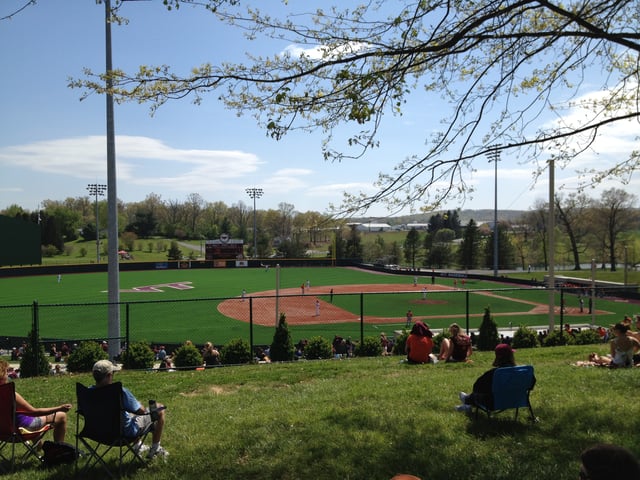
English Field
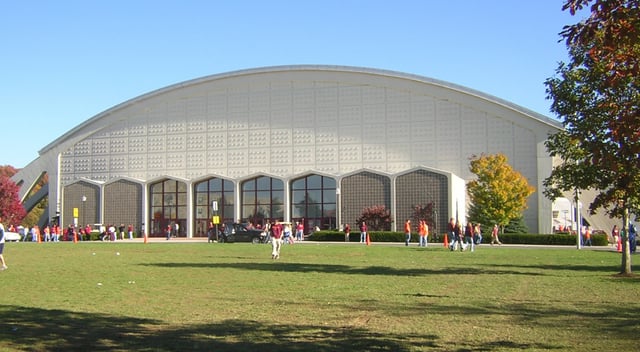
Virginia Tech's Cassell Coliseum
Chuck Hartman, who retired as the Virginia Tech baseball coach in 2006, finished his career as the fourth winningest coach in Division I baseball history with a 1,444–816–8 record, including a 961–591–18 mark in his 28 seasons at Tech, the best record of any baseball coach in history at Tech.
Basketball (men's)
In March 2014, Virginia Tech Director of Athletics Whit Babcock announced the hiring of Buzz Williams as the Hokies' new head men's basketball coach. Williams spent the previous six seasons as the head coach at Marquette University, where he compiled a 139–69 record and led the Golden Eagles to five NCAA appearances, including a trip to the regional finals in the 2012–13 season, the same season that the team won the Big East Conference's regular season title. During Williams's tenure, Marquette tallied a 69–39 record in the Big East Conference, and six Marquette players made it to the NBA.[131] In the Buzz Williams era, Virginia Tech made NCAA Men's Tournament appearances in the 2017, 2018, and 2019 seasons, making it the first time in school history that Virginia Tech has made the NCAA Men's Tournament three years in a row.
In July 2014, Williams announced his staff. Isaac Chew, Steve Roccaforte, and Jamie McNeilly were named assistant coaches. Jeff Reynolds was named the director of men's basketball operations. Devin Johnson will serve as the director of player personnel for men's basketball, and Steve Thomas as the director of student-athlete development. Lyle Wolf joined the staff as the assistant to the head coach, and Ernest Eugene was hired as assistant athletics director for sports medicine and will serve as the team athletic trainer.[132]
Virginia Tech's men's basketball team had seen a resurgence of fan support since the arrival of coach Seth Greenberg in 2003–04 and the university's entry into the ACC in 2004–05. Prior to Coach Greenberg's arrival in Blacksburg, the men's basketball team had not had a winning season since the 1995–96 season, when they received a bid to the NCAA tournament. In addition, the team did not make the Big East tournament in its first three seasons in the conference.
in 2003–04, Greenberg's squad made the Big East tournament. A year later, in their first season in the ACC, the Hokies scored their first postseason berth in nine years when they made the NIT in 2004–05. In the 2006–07 season, Greenberg's Hokies finished with a 10–6 record in the ACC and a 22–12 record overall, earning their first NCAA tournament berth in 11 years, reaching the NCAA second round before losing to Southern Illinois.
Basketball (women's)
Virginia Tech's women's basketball team, led by coach Kenny Brooks, is in a rebuilding phase as it competes in the ACC. Under former coaches Beth Dunkenberger and Bonnie Henrickson, the program was a fixture in postseason play. The Hokies have received nine berths to the NCAA tournament since the program's first in 1994. Virginia Tech's women have also earned five NIT appearances during that stretch including back-to-back appearances in 2016 and 2017.[133]
Both basketball teams play their home games in Cassell Coliseum.
Football
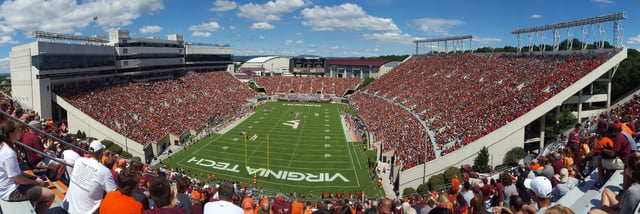
Lane Stadium from the south in 2016
Virginia Tech's football team plays home games in Lane Stadium. With a capacity of 66,233, Lane is relatively small in comparison to many other top FBS stadiums, yet it is still considered to be one of the loudest stadiums in the country. In 2005, it was recognized by rivals.com as having the best home-field advantage in college football.[134]
Frank Beamer was the Hokies' head coach from 1987 to 2015, and was the winningest active head coach in FBS football with 280 wins following the 2015 season. Beamer's teams were known for solid special teams play (called "Beamer Ball") and for tough defenses headed by defensive coordinator Bud Foster. In 2018, Beamer was selected to join the 2018 College Football Hall of Fame.[135]
The Hokies currently hold the longest bowl streak in the country, having participated in bowl games in each of the last 26 seasons. Coach Beamer ended his tenure as head coach with a win in the Independence Bowl in Shreveport, LA, where the Bowl streak began in 1993.[136]
Since the 1995 season, the Hokies have finished with a top-10 ranking five times, won seven conference championships (three Big East and four ACC), and played once for the national championship, losing to Florida State 46–29 in the 2000 Sugar Bowl. Annually, Virginia Tech plays its traditional rival, the University of Virginia, for the Commonwealth Cup, a game which Virginia Tech has won 19 out of the last 20 meetings, including 15 straight.[137]
On November 29, 2015, Virginia Tech Director of Athletics Whit Babcock announced that Justin Fuente was hired from the University of Memphis to succeed the retiring Frank Beamer.
Soccer
Virginia Tech's men's soccer team has improved greatly since the arrival of Oliver Weiss, who has coached the team since 2000. Under Weiss, Tech has made four NCAA tournament appearances, including a trip to the College Cup in 2007. The Hokies' trip to the College Cup is the equivalent of men's basketball Final Four and was the soccer team's most successful season. The Hokies finished the 2007 regular season ranked third nationally.[138]
Women's soccer at Virginia Tech began in 1980 with two club teams under the guidance of Everett Germain and his two daughters, Betsy and Julie. Kelly Cagle was head coach from 2002 to 2010, leaving with a record of 76–70–15 and three consecutive NCAA trips. She was succeeded by Charles "Chugger" Adair.[139] Under Adair the Hokie Women's Soccer quad has spent numerous weeks ranked in the top 25 during their 2012 campaign. During the 2013 season Virginia Tech ranked in the top 5 making it to the Final Four for the first time in school history.[140] The women's team has now been to 6 straight NCAA tournaments 2008–2013 having two Sweet Sixteen finishes and one Final Four finish.
Softball
Virginia Tech Softball upset the USA national team in a 1–0 no hitter in 2008[141] and advanced to the Women's College World Series for the first time ever.[142] Scot Thomas helped start the program in 1996 and celebrated his 600th win during the 2012 season. He was fired following the conclusion of the 2018 season after two consecutive losing seasons. Since joining the ACC, the Virginia Tech Softball team has won two Conference Titles in 2007 and 2008. On May 31, 2018, Pete D'Amour was announced as the new head coach of the Virginia Tech softball program.[143]
Alumni
Since opening in 1872 as Virginia Agricultural and Mechanical College, Virginia Tech has produced a number of distinguished alumni whose contributions have bolstered the university's reputation.[144]
The Virginia Tech Alumni Association includes more than 240,000 living alumni throughout the U.S. and around the world. Virginia Tech alumni can be found in all 50 states and many countries all over the world.
See also
Early Music Ensemble at Virginia Tech
Fighting Gobblers
Hahn Horticulture Garden
List of forestry universities and colleges
Virginia Tech commencement speakers
